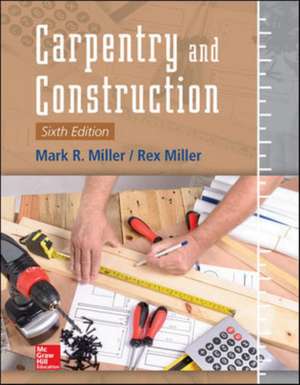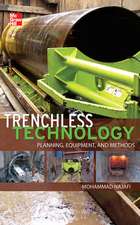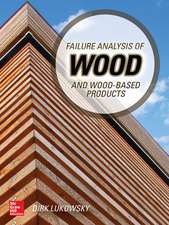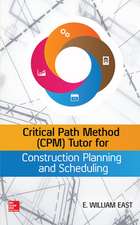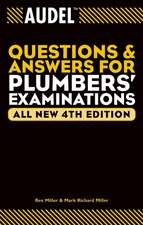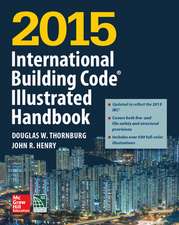Carpentry and Construction, Sixth Edition
Autor Mark Miller, Rex Milleren Limba Engleză Paperback – 16 feb 2016
Publisher's Note: Products purchased from Third Party sellers are not guaranteed by the publisher for quality, authenticity, or access to any online entitlements included with the product.
Fully updated home carpentry, construction, and remodeling instruction
This thoroughly revised, DIY guide takes you through every step of home construction, including remodeling, building additions, and making household repairs. Discover how to select tools, pour foundations, build walls and floors, and install tiles—even handle electrical wiring, plumbing, and insulation! Easy-to-follow instructions, along with more than 1,500 photos and illustrations, clearly demonstrate each technique. Logically organized by building stages, this new edition features the latest tools and materials, information on environmentally friendly building practices, many new and updated images, and a brand new chapter on painting.
Carpentry and Construction, Sixth Edition, shows how to tackle:
• Site preparation
• Footings and foundations
• Concrete slabs and floors
• Floor frames
• Walls and roof framing
• Windows and doors
• Exterior and interior walls
• Electrical Wiring
• Plumbing
• Insulation
• Paint selection and painting techniques
• Interior finishing
• Kitchen and bathroom remodeling
• Tile setting
• Solar heating installation
• Termite prevention
• Installation of Skylights
• Fences, decks, and patios
• Private water and sewage systems
• And much more
Preț: 491.31 lei
Preț vechi: 695.35 lei
-29% Nou
Puncte Express: 737
Preț estimativ în valută:
94.02€ • 97.80$ • 77.62£
94.02€ • 97.80$ • 77.62£
Carte tipărită la comandă
Livrare economică 17-22 aprilie
Preluare comenzi: 021 569.72.76
Specificații
ISBN-13: 9781259587429
ISBN-10: 1259587428
Pagini: 800
Dimensiuni: 218 x 274 x 41 mm
Greutate: 1.66 kg
Ediția:6
Editura: McGraw Hill Education
Colecția McGraw-Hill
Locul publicării:United States
ISBN-10: 1259587428
Pagini: 800
Dimensiuni: 218 x 274 x 41 mm
Greutate: 1.66 kg
Ediția:6
Editura: McGraw Hill Education
Colecția McGraw-Hill
Locul publicării:United States
Cuprins
1 Let’s Get Started
Safety
Other Safety Measures
General Safety Rules
Safety on the Job
Safety Hazards
Using Carpenter Tools
Measuring Tools
Saws
Hammers and Other Small Tools
Squares
Power Tools
Following Correct Sequences
Preparing the Site
The Basement
The Floor
Wall Frames
Sheathing
Roofing
Siding
Finishing
The Laser Level
Chapter 1 Study Questions
2 Site Preparation
Basic Sequence
Locating the Building on the Site
Property Boundaries
Laying Out the Foundation
The Builder’s Level
How Does It Work?
Three Main Parts of a Builder’s Level
Preparing the Instrument
The Level-Transit
Using the Level and Level-Transit
Establishing Elevations
Using the Leveling Rod
Preparing the Site
Clearing
Excavation
Providing Access During Construction
Materials Storage
Temporary Utilities
Waste Disposal
Arranging Delivery Routes
Chapter 2 Study Questions
3 Footings and Foundations
Footings
Sequence
Lay Out the Footings
Soil Strength
Footing Width
Locating Footing Depth
Footings Under Columns
Special Strength Needs
Reinforcement and Strength
Excavating the Footings
Finding Trench Depth
Excavating for Deep Footings
Excavating for Shallow Footings
Slab Footings and Basements
Building the Forms for the Footings
Forms Layout
Nails
Putting Up the Forms
Working with Concrete
Reinforcement
Specifying Concrete
Setting Time
Concrete Estimating
Pouring the Concrete
Slump Test
Building the Foundation Forms
Form Spacing
Constructing the Forms
Joining the Forms Together
Spreaders
Panel Forms
One-Piece Forms
Special Forms
Openings and Special Shapes
Reinforcing Concrete Foundations
Estimating Concrete Volume
Delivery and Pouring
Finishing the Concrete
Concrete Block Walls
Plywood Foundations
Drainage and Waterproofing
Waterproofing Basement Walls
Basement Walls Coatings
Gray Wall
Termites
Types of Termites
Termite Protection
Termites and Treated Wood
Pressure-Treated Wood
Preservatives
Above-Ground and In-Ground Treatment
Nails and Fasteners
Handling and Storing Treated Wood
Chapter 3 Study Questions
4 Concrete Slabs and Floors
Slabs
The Slab Sequence
Types of Slabs
Excavate
Construct the Forms
Prepare the Subsurface
Different Shapes
Pouring the Slab
Expansion and Contraction
Joints
Concrete Floors
Stairs
Sidewalks and Driveways
Sidewalks
Driveways
Special Finishes and Surfaces
Surface Textures
Energy Factors
Chapter 4 Study Questions
5 Floor Frames
Floors
Framing Methods
Balloon-Frame Construction
Platform-Frame Construction
Sequence
Placement of the Sill
Anchor the Sill
Setting Girders
Joists
Lay Out the Joists
Engineered Wood Joists
Cut Joists
Setting the Joists
Fire and Draft Stops
Bridging
Subfloors
Plywood Subfloor
Chipboard and Fiberboard
Laying Sheets
Board Subflooring
Special Joists
Overhangs
Cantilevered In-Line Joist System
Sunken Floors
Low Profiles
Energy Factors
Moisture Barriers
Energy Plenums
Chapter 5 Study Questions
6 Framing Walls
Framing
Sequence
Wall Layout
Plate Layout
Stud Layout
Corner Studs
Partition Studs
Find Stud Length
Frame Rough Openings
Header Size
Cutting Studs to Length
Cutting Tips
Wall Assembly
Nailing Studs to Plates
Corner Braces
Plywood Corner Braces
Diagonal Corner Braces
Erect the Walls
Wall Sheathing
To Raise the Wall
Put Up a Temporary Brace
Interior Walls
Locate Soleplates for Partitions
Studs
Corners
Headers and Trimmers
Soleplate
Special Walls
Soundproofing
Sheathing
Fiberboard Sheathing
Plywood Sheathing
“Energy” Sheathing
Boards
Factors in Wall Construction
Standard Spacing
Notching and Boring
Modular Standards
Energy
Chapter 6 Study Questions
7 Framing the Roof
Roofs
Framing Lumber
Standard Sizes of Bulk Lumber
Grades of Lumber
Roof Shapes
Sequence
Truss Roofs
Truss Construction
Truss Disadvantages
The Framing Square
Parts of the Square
Steel Square Uses
Roof Framing
Roof Terms
Principal Roof Frame Members
Rafters
Layout of a Rafter
Lengths of Rafters
Common Rafters
Hip-and-Valley Rafters
Jack Rafters
Brace Measuring
Erecting the Roof with Rafters
Rafter Layout
Raising Rafters
Special Rafters
Dormers
Bay Windows
Ceiling Joists
Openings
Decking
Plywood Decking
Boards for Decking
Shingle Stringers
Constructing Special Shapes
Gambrel-Shaped-Roof Storage Shed
Mansard Roofs
Post-and-Beam Roofs
Roof Load Factors
Laying Out a Stair
Aluminum Soffit
Material Availability
Metal Connectors
Chapter 7 Study Questions
8 Roofs and Roofing
Roofing
Sequence
Types of Roofs
Drainage Factors
Roofing Terms
Pitch
Slope
Estimating Roofing Quantities
Estimating Area
Horizontal Area
Computation of Roof Areas
Duplications
Converting Horizontal to Slope Areas
Accessories
Length of Rake
Hips and Valleys
Dormer Valleys
Roofing Tools
Safety
Appearance
Applying an Asphalt Roof
Roof Problems
Putting Down Shingles
Nails
Fasteners for Nonwood Materials
Shingle Selection
Cements
Starter Course
Starting at the Center (Hip Roof)
Valleys
Flashing Against a Vertical Wall
Chimneys
Soil Stacks
Strip Shingles
Deck Preparation
First and Succeeding Courses
Ribbon Courses
Wind Protection
Two- and Three-Tab Hex Strips
Hips and Ridges
Steep-Slope and Mansard Roofs
Interlocking Shingles
Hips and Ridges
Roll Roofing
Windy Locations
Exposed Nails—Parallel to the Rake
Hips and Ridges
Wood Shingles
Sizing Up the Job
Roof Exposure
Estimating Shingles Needed
Tools of the Trade
Applying the Shingle Roof
Valleys and Flashings
Shingling at Roof Junctures
Applying Shingles to Hips and Ridges
Nails for Wooden Shingles
Chapter 8 Study Questions
9 Windows and Doors
Sequence
Types of Windows
Preparing the Rough Opening for a Window
Steps in Preparing the Rough Opening
Installing a Wood Window
Installing Windows by Nailing the Flange to the Sheathing
Skylights
Installing a Skylight
Preparing the Roof Opening
Cutting the Roof Opening
Framing the Roof Opening
Mounting the Skylight
Sealing the Installation
Replacing the Shingles
Preparing the Ceiling Opening
Framing the Ceiling Opening
Constructing the Light Shaft
Operation and Maintenance of Skylights
Condensation
Care and Maintenance
Tube-Type Skylights
Terms Used in Window Installation
Prehung Doors
Types of Doors
Installing an Exterior Door
Hanging a Two-Door System
Handing Instructions
Metal Doors
Installing Folding Doors
Door and Window Trim
Interior Door Trim
Window Trim
Installing Locks
Storm Doors and Windows
Installing a Sliding Door
Preparation of the Rough Opening
Installation of a Wood Sliding Door
Masonry or Brick-Veneer Wall Installation of a Sliding Door
Installation of a Perma-Shield Sliding Door
Installing a Garage Door
Energy Factors
Chapter 9 Study Questions
10 Exterior Walls
Walls
Cornice
Types of Siding
Sequence
Job Preparation
Vapor Barrier
Nail Selection
Estimating the Siding Needed
Scaffolding
Job-Built Scaffolds
Factory Scaffolds
Ladder Use
Ladder Safety
Scaffold Safety
Roof Edges
Open Eaves
Enclosed Cornices
Siding the Gable Ends
Installing Siding
Board Siding
Siding Layout
Nailing
Corner Finishing
Panel Siding
Nails and Nailing
Nail Shanks
Nail Points
Screws Instead of Nails
Shingle and Shake Siding
Shingles
Nailing
Shakes
Corners
Preparation for Other Wall Finishes
Stucco Finish
Brick and Stone Coverings
Aluminum Siding
Vertical Aluminum Siding
Solid Vinyl Siding
Chapter 10 Study Questions
11 House Wiring
Local Distribution
Farm Electricity
Safety Around Electricity
Grounded Conductors
House Service
Ground-Fault Circuit Interrupter (GFCI)
Service Entrance
Planning
Permits
Local Regulations
Service from Head to Box
Installation of the Service
Inserting Wire into a Conduit
Distribution Panels
Romex Cable
Wire Size
Planning the Right Size Service and Circuits
150-Ampere Service
Branch Circuits
Electric Space Heating
Air Conditioning
Space Heating and Air-Conditioning Outlets
Entrance Signals
Cable Television
Installing Romex
Box Volume
Lighting Fixtures
Wires and Boxes
Electric Ranges
Connecting Ranges Permanently
Sizing a Range over 12,000 Watts
Tap Conductors
Clothes Dryers
Microwave Ovens
Overhead Garage Doors
Garage Door Opener
Electric Water Heaters
Garbage Disposers
Air Conditioners
Newer Wiring Systems
High-Speed, High-Performance Cable for Voice and Data Applications
Installation of Cable
Service Center
Chapter 11 Study Questions
12 Plumbing
Sequence
Plumbing Systems
Supply Lines
Drains
P Traps and Drains
System Vents
Cleanouts
Planning
Contractors and Plumbers
Pipe Type
Locating Pipes
Chapter 12 Study Questions
13 Insulation
Types of Insulation
How Much Is Enough?
Where to Insulate
Installing Insulation
Installing Insulation in Ceilings
Installation Safety
Installing Insulation in Unfloored Attics
Installing Insulation in Floored Attics
Installing Insulation in Floors
Insulating Basement Walls
Insulating Crawl Spaces
Installing Insulation in Walls
Vapor Barriers and Moisture Control
Condensation
Thermal Ceilings
Installing Thermal Ceiling Panels
Decorative Beams
Storm Windows
Storm Doors
Sealants
Winterizing a Home
Insulating Foam Sealant
Chapter 13 Study Questions
14 Interior Walls and Ceilings
Sequence
Putting Insulation in Walls
Installing a Moisture Barrier
Putting Up Gypsum Board
Putting Up the Ceiling
Applying Ceiling Sheets
Cutting Gypsum Board
Applying Wall Sheets
Double-Ply Construction
Finishing Joints and Seams
Ceiling Panels
Tub and Shower Wall Preparation
Paneling Walls
Board Walls
Plastered Wall Preparation
Nailing Plaster Grounds
Finishing Masonry Walls
Ceiling Tile Installation
Tiles Over Flat Ceilings
Furring Strips Used to Install Ceiling Tile
Suspended Ceilings Installation
Concealed Suspended Ceilings
Environmental Concerns
Chapter 14 Study Questions
15 Interior Finishing
Sequence
Interior Doors and Window Frames
Standard Sizes of Doors
Interior Doors
Doors
Window Trim
Finishing Wooden-Frame Windows
Finishing Metal Window Frames
Cabinets and Millwork
Installing Ready-Built Cabinets
Kitchen Planning
Making Custom Cabinets
Shelves
Applying Finish Trim
Applying Finish Materials
Applying Stain
Applying the Wall Finish
Floor Preparation and Finish
Laying Wooden Flooring
Preparation for Laying Flooring
Finishing Floors
Finishing Wood Floors
Base Flooring for Carpet
Installing Carpet
Resilient Flooring
Installing Resilient Flooring Sheets
Installing Resilient Block Flooring
Laying Ceramic Tile
Environmental Concerns
Chapter 15 Study Questions
16 Paints and Painting
Coatings
Pigments
Paint
Stains
Before You Start Painting
Enamels
Shellac
Proper Surface Preparation
Brushes
Wood Stains
Tung Oil and Lacquer
Lacquer
Paint Scrapers or Removers
Rollers
Spray Guns
Drop Cloths
Setting Up a Ladder
Chapter 16 Study Questions
17 Special Construction Methods
Stairs
Stair Parts
Stair Shapes
Stair Design
Sequence in Stair Construction
Carriage Layout
Frame the Stairs
Install Housed Carriages
Stair Systems
Upeasings, Caps, and Quarterturns
Starting Steps
Treads and Risers
Rosettes and Brackets
Folding Stairs
Locating the Stairway
Making the Rough Opening
Temporary Support for the Stairway
Placing Stairway in the Rough Opening
Adjustments
Fireplace Frames
Ceilings and Roofs Openings
Fireplace Types
General Design Factors
Gas Vents
Round Gas Vent
Air Supply
Vent Connector Type and Size
Vent Location
Clearances and Enclosures
Fire Stopping
Use of Gas-Vent Fittings
Minimum Gas-Vent Height
Support
Gas Termination
Top Installation
Top Installation of 10- to 24-Inch Vents
Checking Vent Operation
Painting
Post-and-Beam Construction
General Procedures
Decks
Platform
Frame
Support
Guard Rails
Raised Deck
Steps
Concrete Patios
Sand and Gravel Base
Expansion Joints
The Mix
Forms
Placing the Joints
Pouring the Concrete
Finishing
Floating
Troweling
Brooming
Grooving
Fences
Installation
Setting Posts
Attaching the Rails
Attaching Fenceboards
Nails and Fasteners
Gates
Energy Conservation
Chapter 17 Study Questions
18 Maintenance and Remodeling
Planning the Job
Diagnosing Problems
Sequencing Work to Be Done
Minor Repairs and Remodeling
Adjusting Doors
Adjusting Locks
Installing Drapery Hardware
Repairing Damaged Sheetrock Walls (Drywall)
Installing New Countertops
Repairing a Leaking Roof
Replacing Guttering
Extruding Gutters to Fit the House
Replacing a Floor
Paneling a Room
Installing a Ceiling
Replacing an Outside Basement Door
Converting Existing Spaces
Adding a Bathroom
Providing Additional Storage
Enclosing a Porch
Adding Space to Existing Buildings
Planning an Addition
Specifications
Creating New Structures
Custom-Built Storage Shed
Environmental Concerns
Chapter 18 Study Questions
19 The Carpenter and the Industry
Broadening Horizons in Carpentry
New Building Materials
Changing Construction Procedures
Innovations in Building Design
Building Codes And Zoning Provisions
Building Codes
Community Planning and Zoning
Overbuilding
Trends and Effects
Manufactured Housing
Types of Factory-Produced Buildings
Premanufactured Apartments
Manufactured Homes
Newer Plastic Pipes
The Green Home and the Carpenter
Carpenters and the Trade
Chapter 19 Study Questions
20 Bathrooms
Room Arrangement
Function and Size
Building Codes
Plumbing
Electrical
Ventilation
Spacing
Other Requirements
Various Types of Floor Coverings
Furnishings
Fixtures
Toilet Selection
Toilet Installation
Bidets
Vanity Areas
Countertop Basins
Other Materials for Countertops
Wall-Mounted Basins
Bathing Areas
Bathtubs
Showers
Fittings
Lighting and Electrical Considerations
Bathroom Built-Ins
Bathroom Layouts
Wheelchair Accessible
Floors and Walls
Environmental Considerations
Chapter 20 Study Questions
21 Construction for Solar Heating
Passive Solar Heating
Indirect Gain
Direct Gain
Isolated Gain
Time-Lag Heating
Underground Heating
Passive Cooling Systems
Natural Ventilation
Induced Ventilation
Desiccant Cooling
Evaporative Cooling
Night-Sky Radiation Cooling
Time-Lag Cooling
Underground Cooling
Active Solar Heating Systems
Operation of Solar Heating Systems
Domestic Water-Heating System
Indirect Heating/Circulating Systems
Air Transfer
Cycle Operation
Designing the Domestic Water-Heating System
Other Components
Is This for Me?
Building Modifications
Building Underground
Advantages
Chapter 21 Study Questions
22 Alternative Framing Methods
Wood Frames Predominate
Steel Framing
Advantages and Disadvantages of Steel-Framed Homes
Types of Steel Framing
Tools Used in Steel Framing
Sequence
Galvanized Framing
Insulated Concrete Forms
Advantages and Disadvantages to ICFs
Tools Used in Insulated Concrete Form Framing
Sequence
Types of Foam
Three Types of ICF Systems
Foam Working Tools
Gluing and Tying Units
Pouring Concrete
Concrete Block
Chapter 22 Study Questions
23 Permanent Wood Foundation System
Panel Foundations
Building Materials
Energy Considerations
Finishing
Adding Living Space
Remodeling
Flexibility
Pressure-Treated Wood Concerns and Considerations
Types of Wood Preservative
Constructing the PWF
Radon
Advantages of the PWF
Soil Conditions
Site Preparation
Footings and Backfill
Site Drainage
Building the PWF Step by Step
Finishing a PWF House
24 Private Water Systems
Public Water Supplies
Private Water Systems
Drilling a Well, Boring a Well, or Driving a Well
Drinking Water
Well Water
Water Pressure
Pressure Tanks
Operation of the Pressure Tank
Pressure Switch
Relief Valve (Pressure)
Pump Installation
Test Run
Pressure Tank Installation
Water Conditioning Equipment
Locating the Equipment
Chapter 24 Study Questions
25 Private Sewage Facilities
Septic Tanks and Disposal Fields
Septic Tank Operation
Septic Tank Location
Septic Tank Disposal Field
The Grease Trap
Newer Wastewater Treatments
Environmental Concerns
Chapter 25 Study Questions
Glossary
Index
Safety
Other Safety Measures
General Safety Rules
Safety on the Job
Safety Hazards
Using Carpenter Tools
Measuring Tools
Saws
Hammers and Other Small Tools
Squares
Power Tools
Following Correct Sequences
Preparing the Site
The Basement
The Floor
Wall Frames
Sheathing
Roofing
Siding
Finishing
The Laser Level
Chapter 1 Study Questions
2 Site Preparation
Basic Sequence
Locating the Building on the Site
Property Boundaries
Laying Out the Foundation
The Builder’s Level
How Does It Work?
Three Main Parts of a Builder’s Level
Preparing the Instrument
The Level-Transit
Using the Level and Level-Transit
Establishing Elevations
Using the Leveling Rod
Preparing the Site
Clearing
Excavation
Providing Access During Construction
Materials Storage
Temporary Utilities
Waste Disposal
Arranging Delivery Routes
Chapter 2 Study Questions
3 Footings and Foundations
Footings
Sequence
Lay Out the Footings
Soil Strength
Footing Width
Locating Footing Depth
Footings Under Columns
Special Strength Needs
Reinforcement and Strength
Excavating the Footings
Finding Trench Depth
Excavating for Deep Footings
Excavating for Shallow Footings
Slab Footings and Basements
Building the Forms for the Footings
Forms Layout
Nails
Putting Up the Forms
Working with Concrete
Reinforcement
Specifying Concrete
Setting Time
Concrete Estimating
Pouring the Concrete
Slump Test
Building the Foundation Forms
Form Spacing
Constructing the Forms
Joining the Forms Together
Spreaders
Panel Forms
One-Piece Forms
Special Forms
Openings and Special Shapes
Reinforcing Concrete Foundations
Estimating Concrete Volume
Delivery and Pouring
Finishing the Concrete
Concrete Block Walls
Plywood Foundations
Drainage and Waterproofing
Waterproofing Basement Walls
Basement Walls Coatings
Gray Wall
Termites
Types of Termites
Termite Protection
Termites and Treated Wood
Pressure-Treated Wood
Preservatives
Above-Ground and In-Ground Treatment
Nails and Fasteners
Handling and Storing Treated Wood
Chapter 3 Study Questions
4 Concrete Slabs and Floors
Slabs
The Slab Sequence
Types of Slabs
Excavate
Construct the Forms
Prepare the Subsurface
Different Shapes
Pouring the Slab
Expansion and Contraction
Joints
Concrete Floors
Stairs
Sidewalks and Driveways
Sidewalks
Driveways
Special Finishes and Surfaces
Surface Textures
Energy Factors
Chapter 4 Study Questions
5 Floor Frames
Floors
Framing Methods
Balloon-Frame Construction
Platform-Frame Construction
Sequence
Placement of the Sill
Anchor the Sill
Setting Girders
Joists
Lay Out the Joists
Engineered Wood Joists
Cut Joists
Setting the Joists
Fire and Draft Stops
Bridging
Subfloors
Plywood Subfloor
Chipboard and Fiberboard
Laying Sheets
Board Subflooring
Special Joists
Overhangs
Cantilevered In-Line Joist System
Sunken Floors
Low Profiles
Energy Factors
Moisture Barriers
Energy Plenums
Chapter 5 Study Questions
6 Framing Walls
Framing
Sequence
Wall Layout
Plate Layout
Stud Layout
Corner Studs
Partition Studs
Find Stud Length
Frame Rough Openings
Header Size
Cutting Studs to Length
Cutting Tips
Wall Assembly
Nailing Studs to Plates
Corner Braces
Plywood Corner Braces
Diagonal Corner Braces
Erect the Walls
Wall Sheathing
To Raise the Wall
Put Up a Temporary Brace
Interior Walls
Locate Soleplates for Partitions
Studs
Corners
Headers and Trimmers
Soleplate
Special Walls
Soundproofing
Sheathing
Fiberboard Sheathing
Plywood Sheathing
“Energy” Sheathing
Boards
Factors in Wall Construction
Standard Spacing
Notching and Boring
Modular Standards
Energy
Chapter 6 Study Questions
7 Framing the Roof
Roofs
Framing Lumber
Standard Sizes of Bulk Lumber
Grades of Lumber
Roof Shapes
Sequence
Truss Roofs
Truss Construction
Truss Disadvantages
The Framing Square
Parts of the Square
Steel Square Uses
Roof Framing
Roof Terms
Principal Roof Frame Members
Rafters
Layout of a Rafter
Lengths of Rafters
Common Rafters
Hip-and-Valley Rafters
Jack Rafters
Brace Measuring
Erecting the Roof with Rafters
Rafter Layout
Raising Rafters
Special Rafters
Dormers
Bay Windows
Ceiling Joists
Openings
Decking
Plywood Decking
Boards for Decking
Shingle Stringers
Constructing Special Shapes
Gambrel-Shaped-Roof Storage Shed
Mansard Roofs
Post-and-Beam Roofs
Roof Load Factors
Laying Out a Stair
Aluminum Soffit
Material Availability
Metal Connectors
Chapter 7 Study Questions
8 Roofs and Roofing
Roofing
Sequence
Types of Roofs
Drainage Factors
Roofing Terms
Pitch
Slope
Estimating Roofing Quantities
Estimating Area
Horizontal Area
Computation of Roof Areas
Duplications
Converting Horizontal to Slope Areas
Accessories
Length of Rake
Hips and Valleys
Dormer Valleys
Roofing Tools
Safety
Appearance
Applying an Asphalt Roof
Roof Problems
Putting Down Shingles
Nails
Fasteners for Nonwood Materials
Shingle Selection
Cements
Starter Course
Starting at the Center (Hip Roof)
Valleys
Flashing Against a Vertical Wall
Chimneys
Soil Stacks
Strip Shingles
Deck Preparation
First and Succeeding Courses
Ribbon Courses
Wind Protection
Two- and Three-Tab Hex Strips
Hips and Ridges
Steep-Slope and Mansard Roofs
Interlocking Shingles
Hips and Ridges
Roll Roofing
Windy Locations
Exposed Nails—Parallel to the Rake
Hips and Ridges
Wood Shingles
Sizing Up the Job
Roof Exposure
Estimating Shingles Needed
Tools of the Trade
Applying the Shingle Roof
Valleys and Flashings
Shingling at Roof Junctures
Applying Shingles to Hips and Ridges
Nails for Wooden Shingles
Chapter 8 Study Questions
9 Windows and Doors
Sequence
Types of Windows
Preparing the Rough Opening for a Window
Steps in Preparing the Rough Opening
Installing a Wood Window
Installing Windows by Nailing the Flange to the Sheathing
Skylights
Installing a Skylight
Preparing the Roof Opening
Cutting the Roof Opening
Framing the Roof Opening
Mounting the Skylight
Sealing the Installation
Replacing the Shingles
Preparing the Ceiling Opening
Framing the Ceiling Opening
Constructing the Light Shaft
Operation and Maintenance of Skylights
Condensation
Care and Maintenance
Tube-Type Skylights
Terms Used in Window Installation
Prehung Doors
Types of Doors
Installing an Exterior Door
Hanging a Two-Door System
Handing Instructions
Metal Doors
Installing Folding Doors
Door and Window Trim
Interior Door Trim
Window Trim
Installing Locks
Storm Doors and Windows
Installing a Sliding Door
Preparation of the Rough Opening
Installation of a Wood Sliding Door
Masonry or Brick-Veneer Wall Installation of a Sliding Door
Installation of a Perma-Shield Sliding Door
Installing a Garage Door
Energy Factors
Chapter 9 Study Questions
10 Exterior Walls
Walls
Cornice
Types of Siding
Sequence
Job Preparation
Vapor Barrier
Nail Selection
Estimating the Siding Needed
Scaffolding
Job-Built Scaffolds
Factory Scaffolds
Ladder Use
Ladder Safety
Scaffold Safety
Roof Edges
Open Eaves
Enclosed Cornices
Siding the Gable Ends
Installing Siding
Board Siding
Siding Layout
Nailing
Corner Finishing
Panel Siding
Nails and Nailing
Nail Shanks
Nail Points
Screws Instead of Nails
Shingle and Shake Siding
Shingles
Nailing
Shakes
Corners
Preparation for Other Wall Finishes
Stucco Finish
Brick and Stone Coverings
Aluminum Siding
Vertical Aluminum Siding
Solid Vinyl Siding
Chapter 10 Study Questions
11 House Wiring
Local Distribution
Farm Electricity
Safety Around Electricity
Grounded Conductors
House Service
Ground-Fault Circuit Interrupter (GFCI)
Service Entrance
Planning
Permits
Local Regulations
Service from Head to Box
Installation of the Service
Inserting Wire into a Conduit
Distribution Panels
Romex Cable
Wire Size
Planning the Right Size Service and Circuits
150-Ampere Service
Branch Circuits
Electric Space Heating
Air Conditioning
Space Heating and Air-Conditioning Outlets
Entrance Signals
Cable Television
Installing Romex
Box Volume
Lighting Fixtures
Wires and Boxes
Electric Ranges
Connecting Ranges Permanently
Sizing a Range over 12,000 Watts
Tap Conductors
Clothes Dryers
Microwave Ovens
Overhead Garage Doors
Garage Door Opener
Electric Water Heaters
Garbage Disposers
Air Conditioners
Newer Wiring Systems
High-Speed, High-Performance Cable for Voice and Data Applications
Installation of Cable
Service Center
Chapter 11 Study Questions
12 Plumbing
Sequence
Plumbing Systems
Supply Lines
Drains
P Traps and Drains
System Vents
Cleanouts
Planning
Contractors and Plumbers
Pipe Type
Locating Pipes
Chapter 12 Study Questions
13 Insulation
Types of Insulation
How Much Is Enough?
Where to Insulate
Installing Insulation
Installing Insulation in Ceilings
Installation Safety
Installing Insulation in Unfloored Attics
Installing Insulation in Floored Attics
Installing Insulation in Floors
Insulating Basement Walls
Insulating Crawl Spaces
Installing Insulation in Walls
Vapor Barriers and Moisture Control
Condensation
Thermal Ceilings
Installing Thermal Ceiling Panels
Decorative Beams
Storm Windows
Storm Doors
Sealants
Winterizing a Home
Insulating Foam Sealant
Chapter 13 Study Questions
14 Interior Walls and Ceilings
Sequence
Putting Insulation in Walls
Installing a Moisture Barrier
Putting Up Gypsum Board
Putting Up the Ceiling
Applying Ceiling Sheets
Cutting Gypsum Board
Applying Wall Sheets
Double-Ply Construction
Finishing Joints and Seams
Ceiling Panels
Tub and Shower Wall Preparation
Paneling Walls
Board Walls
Plastered Wall Preparation
Nailing Plaster Grounds
Finishing Masonry Walls
Ceiling Tile Installation
Tiles Over Flat Ceilings
Furring Strips Used to Install Ceiling Tile
Suspended Ceilings Installation
Concealed Suspended Ceilings
Environmental Concerns
Chapter 14 Study Questions
15 Interior Finishing
Sequence
Interior Doors and Window Frames
Standard Sizes of Doors
Interior Doors
Doors
Window Trim
Finishing Wooden-Frame Windows
Finishing Metal Window Frames
Cabinets and Millwork
Installing Ready-Built Cabinets
Kitchen Planning
Making Custom Cabinets
Shelves
Applying Finish Trim
Applying Finish Materials
Applying Stain
Applying the Wall Finish
Floor Preparation and Finish
Laying Wooden Flooring
Preparation for Laying Flooring
Finishing Floors
Finishing Wood Floors
Base Flooring for Carpet
Installing Carpet
Resilient Flooring
Installing Resilient Flooring Sheets
Installing Resilient Block Flooring
Laying Ceramic Tile
Environmental Concerns
Chapter 15 Study Questions
16 Paints and Painting
Coatings
Pigments
Paint
Stains
Before You Start Painting
Enamels
Shellac
Proper Surface Preparation
Brushes
Wood Stains
Tung Oil and Lacquer
Lacquer
Paint Scrapers or Removers
Rollers
Spray Guns
Drop Cloths
Setting Up a Ladder
Chapter 16 Study Questions
17 Special Construction Methods
Stairs
Stair Parts
Stair Shapes
Stair Design
Sequence in Stair Construction
Carriage Layout
Frame the Stairs
Install Housed Carriages
Stair Systems
Upeasings, Caps, and Quarterturns
Starting Steps
Treads and Risers
Rosettes and Brackets
Folding Stairs
Locating the Stairway
Making the Rough Opening
Temporary Support for the Stairway
Placing Stairway in the Rough Opening
Adjustments
Fireplace Frames
Ceilings and Roofs Openings
Fireplace Types
General Design Factors
Gas Vents
Round Gas Vent
Air Supply
Vent Connector Type and Size
Vent Location
Clearances and Enclosures
Fire Stopping
Use of Gas-Vent Fittings
Minimum Gas-Vent Height
Support
Gas Termination
Top Installation
Top Installation of 10- to 24-Inch Vents
Checking Vent Operation
Painting
Post-and-Beam Construction
General Procedures
Decks
Platform
Frame
Support
Guard Rails
Raised Deck
Steps
Concrete Patios
Sand and Gravel Base
Expansion Joints
The Mix
Forms
Placing the Joints
Pouring the Concrete
Finishing
Floating
Troweling
Brooming
Grooving
Fences
Installation
Setting Posts
Attaching the Rails
Attaching Fenceboards
Nails and Fasteners
Gates
Energy Conservation
Chapter 17 Study Questions
18 Maintenance and Remodeling
Planning the Job
Diagnosing Problems
Sequencing Work to Be Done
Minor Repairs and Remodeling
Adjusting Doors
Adjusting Locks
Installing Drapery Hardware
Repairing Damaged Sheetrock Walls (Drywall)
Installing New Countertops
Repairing a Leaking Roof
Replacing Guttering
Extruding Gutters to Fit the House
Replacing a Floor
Paneling a Room
Installing a Ceiling
Replacing an Outside Basement Door
Converting Existing Spaces
Adding a Bathroom
Providing Additional Storage
Enclosing a Porch
Adding Space to Existing Buildings
Planning an Addition
Specifications
Creating New Structures
Custom-Built Storage Shed
Environmental Concerns
Chapter 18 Study Questions
19 The Carpenter and the Industry
Broadening Horizons in Carpentry
New Building Materials
Changing Construction Procedures
Innovations in Building Design
Building Codes And Zoning Provisions
Building Codes
Community Planning and Zoning
Overbuilding
Trends and Effects
Manufactured Housing
Types of Factory-Produced Buildings
Premanufactured Apartments
Manufactured Homes
Newer Plastic Pipes
The Green Home and the Carpenter
Carpenters and the Trade
Chapter 19 Study Questions
20 Bathrooms
Room Arrangement
Function and Size
Building Codes
Plumbing
Electrical
Ventilation
Spacing
Other Requirements
Various Types of Floor Coverings
Furnishings
Fixtures
Toilet Selection
Toilet Installation
Bidets
Vanity Areas
Countertop Basins
Other Materials for Countertops
Wall-Mounted Basins
Bathing Areas
Bathtubs
Showers
Fittings
Lighting and Electrical Considerations
Bathroom Built-Ins
Bathroom Layouts
Wheelchair Accessible
Floors and Walls
Environmental Considerations
Chapter 20 Study Questions
21 Construction for Solar Heating
Passive Solar Heating
Indirect Gain
Direct Gain
Isolated Gain
Time-Lag Heating
Underground Heating
Passive Cooling Systems
Natural Ventilation
Induced Ventilation
Desiccant Cooling
Evaporative Cooling
Night-Sky Radiation Cooling
Time-Lag Cooling
Underground Cooling
Active Solar Heating Systems
Operation of Solar Heating Systems
Domestic Water-Heating System
Indirect Heating/Circulating Systems
Air Transfer
Cycle Operation
Designing the Domestic Water-Heating System
Other Components
Is This for Me?
Building Modifications
Building Underground
Advantages
Chapter 21 Study Questions
22 Alternative Framing Methods
Wood Frames Predominate
Steel Framing
Advantages and Disadvantages of Steel-Framed Homes
Types of Steel Framing
Tools Used in Steel Framing
Sequence
Galvanized Framing
Insulated Concrete Forms
Advantages and Disadvantages to ICFs
Tools Used in Insulated Concrete Form Framing
Sequence
Types of Foam
Three Types of ICF Systems
Foam Working Tools
Gluing and Tying Units
Pouring Concrete
Concrete Block
Chapter 22 Study Questions
23 Permanent Wood Foundation System
Panel Foundations
Building Materials
Energy Considerations
Finishing
Adding Living Space
Remodeling
Flexibility
Pressure-Treated Wood Concerns and Considerations
Types of Wood Preservative
Constructing the PWF
Radon
Advantages of the PWF
Soil Conditions
Site Preparation
Footings and Backfill
Site Drainage
Building the PWF Step by Step
Finishing a PWF House
24 Private Water Systems
Public Water Supplies
Private Water Systems
Drilling a Well, Boring a Well, or Driving a Well
Drinking Water
Well Water
Water Pressure
Pressure Tanks
Operation of the Pressure Tank
Pressure Switch
Relief Valve (Pressure)
Pump Installation
Test Run
Pressure Tank Installation
Water Conditioning Equipment
Locating the Equipment
Chapter 24 Study Questions
25 Private Sewage Facilities
Septic Tanks and Disposal Fields
Septic Tank Operation
Septic Tank Location
Septic Tank Disposal Field
The Grease Trap
Newer Wastewater Treatments
Environmental Concerns
Chapter 25 Study Questions
Glossary
Index
